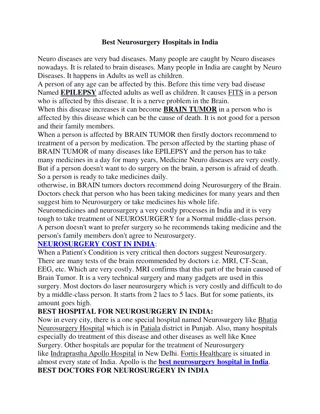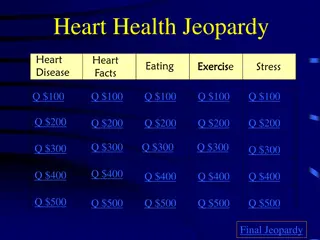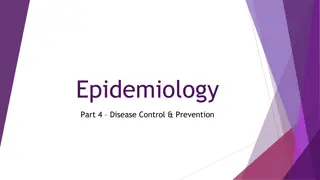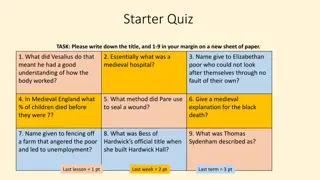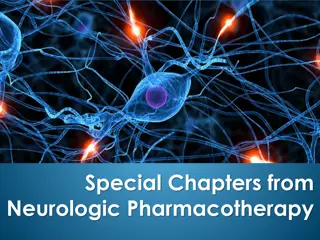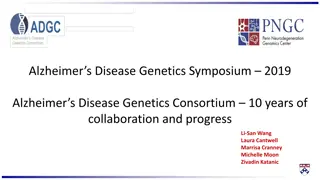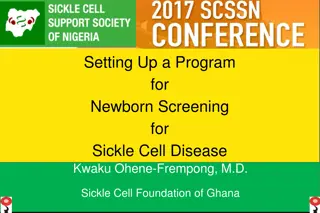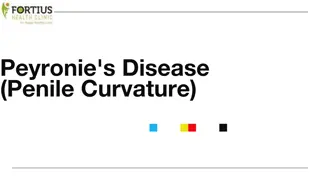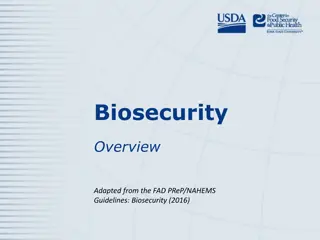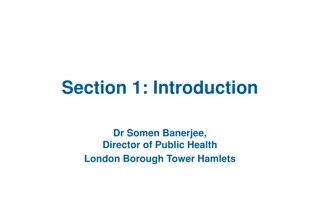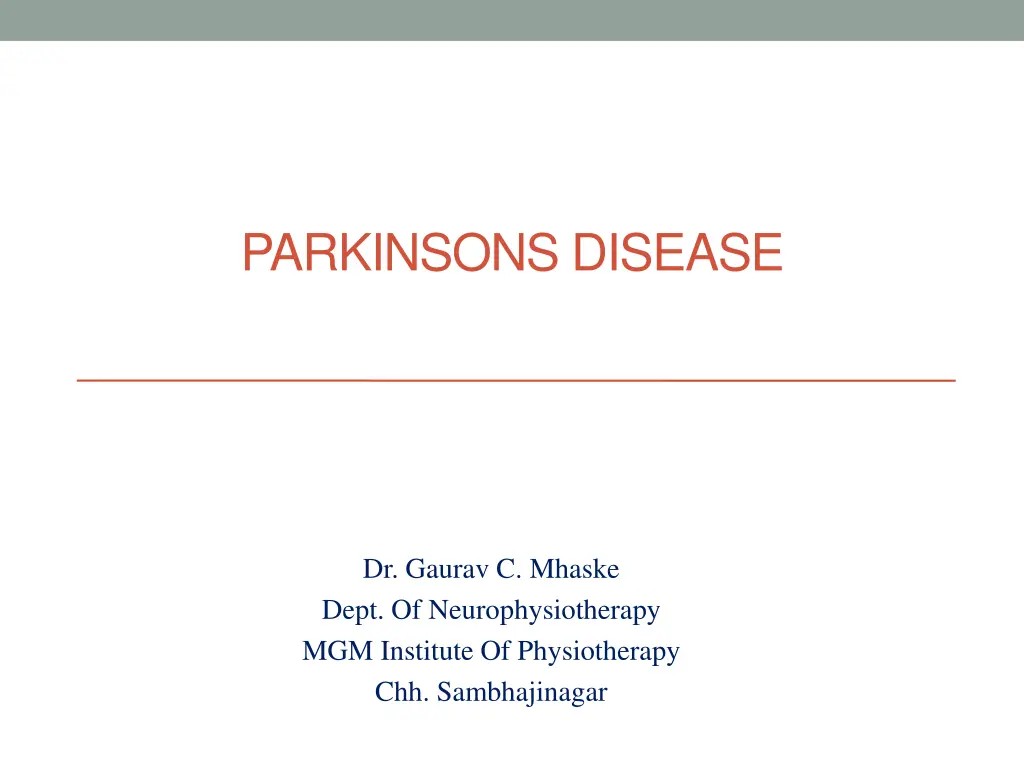
Understanding Parkinson's Disease: Symptoms & Progression
Explore the history, symptoms, and progression of Parkinson's Disease, a chronic neurodegenerative disorder affecting movement. Learn about the cardinal features such as rigidity, tremors, and postural instability, as well as other associated symptoms. Discover the impact of Parkinson's on daily activities and the autonomic nervous system. Despite being incurable, management strategies can help improve quality of life for individuals with Parkinson's Disease.
Download Presentation

Please find below an Image/Link to download the presentation.
The content on the website is provided AS IS for your information and personal use only. It may not be sold, licensed, or shared on other websites without obtaining consent from the author. If you encounter any issues during the download, it is possible that the publisher has removed the file from their server.
You are allowed to download the files provided on this website for personal or commercial use, subject to the condition that they are used lawfully. All files are the property of their respective owners.
The content on the website is provided AS IS for your information and personal use only. It may not be sold, licensed, or shared on other websites without obtaining consent from the author.
E N D
Presentation Transcript
PARKINSONS DISEASE Dr. Gaurav C. Mhaske Dept. Of Neurophysiotherapy MGM Institute Of Physiotherapy Chh. Sambhajinagar
History of Parkinsons disease (PD) First described in 1817 by an English physician, James Parkinson, in An Essay on the Shaking Palsy. The famous French neurologist, Charcot, further described the syndrome in the late 1800s. Epidemiology of PD The most common movement disorder affecting 1-2 % of the general population over the age of 65 years. The second most common neurodegenerative disorder after Alzheimer s disease (AD).
Introduction PARKINSONS DISEASE is a chronic progressive disease of nervous system characterized by cardinal features of rigidity, bradykinesia, tremors and postural instability. In addition the disease may cause a variety of other symptoms including movement and gait disturbances, sensory changes, speech, voice and swallowing disorders, cognitive and behavioral changes, ANS dysfunction, GI changes and cardiopulmonary changes.
A progressive neurodegenerative disorder characterized by the loss of dopaminergic neurons in the substantia nigra of the brain Affects movement Although PD isn t fatal, it is progressive and incurable Even with medications, symptoms vary in incidence, severity, and timing from person to person day to day
Four Primary Symptoms of PD Tremor/trembling in limbs, jaw and face (at rest) Most common first symptom, usually asymmetric and most evident in one hand with the arm at rest. Rigidity or stiffness of the limbs and trunk, Muscle tone increased in both flexor and extensor muscles providing a constant resistance to passive movements of the joints; stooped posture, anteroflexed head, and flexed knees and elbows Akinesia (lack/slowness of initiating or maintaining movement) Difficulty with daily activities such as writing, shaving, using a knife and fork, and opening buttons; decreased blinking, masked facies, slowed chewing and swallowing. Postural instability/impaired balance and coordination due to loss of postural reflexes Loss of postural reflexes causes balance difficulties and the body can move or fall into the direction of the center of gravity. Therefore, turning or bending forward may be associated with involuntary steps
Other Signs and Symptoms Dysfunction of the autonomic nervous system: Impaired gastrointestinal motility, bladder dysfunction, sialorrhea, excessive head and neck sweating, and orthostatic hypotension. Autonomic dysfunction can result into impaired gastrointestinal motility causing sense of fulness and constipation. Furthermore, bladder dysfunction (urinary frequency, urgency and urge incontinence), sialorrhea (due to excessive saliva production and decreased frequency of swallowing), excessive head and neck sweating (resulting from altered thermoregulation), and orthostatic hypotension result from autonomic dysfunction Depression: Mild to moderate depression in 50 % of patients. Cognitive impairment: Mild cognitive decline including impaired visual-spatial perception and attention, slowness in execution of motor tasks, and impaired concentration in most patients; at least 1/3 become demented during the course of the disease.
Classification of Parkinsonism Idiopathic PD PD due to identifiable causes e.g. viruses, toxins, drugs, vascular diseases, tumors, normal pressure hydrocephalous, metabolic. PD in other Neurodegenerative disorders
Neuropathology of PD Eosinophilic, round intracytoplasmic inclusions called lewy bodies and Lewy neurites. First described in 1912 by a German neuropathologist - Friedrich Lewy. Inclusions particularly numerous in the substantia nigra pars compacta. Later the focal distribution of pathology was shown: the most pronounced nerve cell loss is found in the pars compacta of the substantia nigra.
On the left a Lewy body of substantia nigra section from a PD patient labeled with a polyclocal -synuclein antibody NAC-1 at 1:100. On the right cortical Lewy bodies of cingulate gyrus labelled with NAC-1 at 1:200. Bars 20 m. -synuclein accumulates in Lewy bodies in Parkinson's disease and dementia with Lewy bodies but not in Alzheimer's disease -amyloid plaque cores. The presence of Lewy bodies is not limited to substantia nigra: they are also found in the locus coeruleus, motor nucleus of the vagus nerve, the hypothalamus, the nucleus basalis of Meynert, the cerebral cortex, the olfactory bulb and the autonomic nervous system. Lewy bodies are confined largely to neurons; glial cells are only rarely affected.
Functional neuroanatomy of PD Substantia nigra is the major origin of the dopaminergic innervation of the striatum and is a part of extrapyramidal system which processes information coming from the cortex to the striatum, and returns it back to the cortex through the thalamus. One major function of the striatum, which is under the control of substantia nigra, is the regulation of posture and muscle tonus.
CORTEX + + STRIATUM D1 D2 D1 GPe SNc SNr STN GPi + + THALAMUS NORMAL MOTOR CONTROL
Neurochemistry of PD In late 1950s, it was shown that dopamine is present in mammalian brain, and that the levels are highest within the striatum. In 1960, Ehringer and Hornykiewicz showed that the levels of dopamine are severely reduced in the striatum of patients with PD. Degeneration of the nigrostriatal dopaminergic neurons causes symptoms of PD: symptoms become manifest when about 50- 60 % of the dopamine-containing neurons in the substantia nigra and 70-80 % of striatal dopamine are lost.
Dopamine pathways in human brain The ventral tegmental area (VTA) cells project to limbic (mesolimbic projection) and cortical (mesocortical projection) areas. Neurons of the substantia nigra project to the striatum (nigrostriatal projection). In PD, dopaminergic nerve cells in the substantia nigra develop nerve cell loss, and its degeneration and the resulting striatal dopamine depletion are responsible for most of the motor abnormalities.
Hoen and Yahr Classification I Minimal or absent; unilateral if present II Minimal bilateral or midline involvement, Balance not impaired III Impaired righting reflexes, unsteadiness when turning or rising from chair. Some activities are restricted, but patient can live independently and continue some forms of employment IV All symptoms present and severe. Standing and walking possible only with assistance V Confined to bed or wheelchair.
Treatment of PD No cure currently exists Treatment does not stop the progression of the disease Offers symptomatic relief Can temporarily restore function Can enhance Quality Of Life Each individual responds to drugs differently
Pharmacological Treatment Mild symptoms may not require medication When prescription drugs are needed, they help to manage symptoms, but cannot stop the progression of the disease When a drug no longer effectively controls symptoms, another drug may be added to existing therapy Optimal management is highly individualized and is best determined by a doctor who specializes in the treatment of PD
Medications Levodopa Converted to dopamine in the brain, which is responsible for transmitting signals in the brain allowing for normal movements Often combined with Carbidopa (Sinemet), which the amount of Levodopa that goes to the brain COMT inhibitors Blocks the action of catechol-O-methyltransferase, an enzyme that breaks down dopamine. Entacapone (Comtan) and Tolcapone (Tasmar)
Medications Dopamine agonists Act like dopamine within the brain Bromocriptine (Parlodel), Pramipexole (Mirapex), Ropinirole (Requip), and Apomorphine (Apokyn) Amantadine Unknown mechanism; may brain s response to dopamine or releases stored dopamine Amantadine (Symmetrel)
Medications Anticholinergics Exert a relaxing effect on the body Benztropine Mesylate (Congetin), Procyclidine (Kemadrin), Biperiden (Akineton), and Trihexyphenidyl Selegiline Unknown mechanism Appears to inhibit the breakdown of dopamine Usually added to a patient s therapy when effectiveness of Levodopa is Selegiline (Zalapar, Eldepyrl, Emsam)
Stereotactic Surgery and Parkinson's Disease Functional neurosurgery comprises treatment of several disorders such as Parkinson s disease, hyperkinesis, disorder of muscle tone, intractable pain, convulsive disorders and psychological phenomena. Treatment for these phenomena was believed to be located in the superficial parts of the CNS and PNS. Most of the interventions made for treatment consisted of cortical extirpation. To alleviate extra pyramidal disorders, pioneer Russell Meyers dissected or transected the head of the caudate nucleus in 1939, and part of the putamen and globus pallidus. Attempts to abolish intractable pain were made with success by transaction of the spinothalamic tract at spinal modullary level and further proximally, even at meencephalic levels.
In 1939-1941 Putnam and Oliver tried to improve Parkinsonism and hyperkinesias by trying a series of modifications of the lateral and antero-lateral cordotomies. Additionally, other scientists like Schurman, Walker, and Guiot made significant contributions to functional neurosurgery. In 1953, Cooper discovered by chance that ligation of the anterior chorioidal artery resulted in improvement of Parkinson's disease. Similarly, when Grood was performing an operation in a patient with Parkinson s, he accidentally lesioned the thalamus. This caused the patient s tremors to stop. From then on, thalamic lesions became the target point with more satisfactory results.
More recent clinical applications were seen at the University of Virginia School of Medicine, where Deep Brain Stimulation (DBS), Pallidotomy and Thalamotomy are surgeries used to treat Parkinson s disease. During DBS, an electrode is placed into the thalamus, the pallidum of the subthalmamic nucleus, parts of brain that are involved in motor control, and are affected by Parkinson s Disease. The electrode is connected to a small battery operated stimulator that is placed under the clavicle, where a wire runs beneath the skin to connect it to the electrode in the brain. The stimulator produces electrical impulses that affect the nerve cells around the electrode and should help alleviate tremors or symptoms that are associated with the affected area.
In Thalamotomy, a needle electrode is placed into the thalamus, and the patient must cooperate with tasks assigned to find the affected area- after this area of the thalamus is located, a small high frequency current is applied to the electrode and this destroys a small part of the thalamus. Approximately 90% of patients experience instantaneous tremor relief. In Pallidotomy, an almost identical procedure to thalamotomy, a small part of the palladium is destroyed and 80% of patients see improvement in rigidity and hypokinesia and a tremor relief or improvement comes weeks after the procedure.
Goals of PT Treatment Fall prevention Correct deficits Transfers and bed mobility Strengthening of trunk, shoulders, hips Balance and coordination Swiss ball exercises Squats Reaching out beyond BOS Weight shifting marching, kicking ball
PD patients with more than 1 fall in previous year are likely to fall again Most falls occur during transfers and freezing of gait Therefore, PT should focus on: Promoting active lifestyle Active exercises to improve balance, muscle power, joint mobility, and aerobic capacity Cueing strategies Postural adjustments in bed or W/C Assisted active exercises Education to prevent pressure sores and contractures
Abnormal Gait Patterns with PD Difficulty weight shifting or initiating movement Hypokinesia, associated with reduced walking speed and step length Episodes of freezing motor blocks Impaired balance and postural reactions upright stance with narrow BOS
Cueing Strategies Used during gait training Auditory cues rhythmic music, metronome, counting Visual cues stepping over stripes on floor, focus on an object, colors Tactile cues tapping on hip, leg, etc. Cognitive cues mental image of appropriate step length
Exercises Focus on ROM, gait, balance, antirigidity, ADLs Leg strength use equipment, resistive bands Balance/sway foam pads, wobble boards, swiss ball Strengthen trunk muscles for respiration and posture Weight shifting Exercises for transfers
Exercises Stretching exercises are essential Posterior direction: reaching backwards, walking backwards Extension exercises Throwing/kicking a ball Push-ups PROM PNF Respiration exercises Relaxation exercises Yoga, Tai Chi Karate exercises shown to tremors and dexterity and coordination Energy Conservation
Tai Chi The slow, rhythmic pace of functionally based exercises, helps in internal organ stimulation, flexibility maintenance, balance training effects are general health benefits of Tai Chi Relevant to PD management: fall prevention, tremor reduction, and motor control
Balance Training & High-Intensity Resistance Training PD patients have dyssynchrony of leg muscles during movement initiation Reduced peak torque production in knee extension, flexion, and ankle dorsiflexion LE weakness impairs postural responses to challenged balance High intensity resistance training of knee extensors, flexors, ankle plantarflexors Cycle ergometer
Treadmill Training Many studies conducted and treadmill training shown to be effective in gait training At initial sessions, all patients could walk without freezing phenomenon at higher treadmill speeds Improvement in gait speed and number of steps Effects lasted for less period of time
Treadmill Training Possible that body-weight supported (overhead suspension harness) treadmill training induces implicit motor learning by enhancing alternative brain networks Has potential to enhance gait rhythmicity Progressive and intensive treadmill training can minimize impairments in gait, reduce fall risk and quality of life Positive Aspects of treadmill training: Rhythmicity Weight-support Aerobic training External pacemaker
Stretch Reflex Trager Method muscle rigidity hypothesized to be caused by enhanced activity of a long latency component of the stretch reflex Manual segmental vibration characteristic of the Trager method, consists of imparting low-frequency movements to a limb to produce a brief but substantal reduction in the H-reflex (stretch reflex) Suggests that imparting rocking motions to a body segment can alter the activity of the reflex pathways
Stretch Reflex Trager Approach: imparts a series of very gently painless, passive rocking motions to the limbs Significant reduction of evoked stretch response was observed; may induce a reduction of the muscle rigidity seen in patients with PD More effective in supine than sitting
Lastly Family & Patient Education



